
Score breakdown
Things we like
- Variable dampers deliver ride comfort and body control
- Quality cabin with suitably sporty aesthetic
- Third-row flexibility
Not so much
- Artificial engine sound; disobedient gearbox
- Not especially quick
- Tiguan R looks better value if extra seats aren’t needed
It’s rare for a vehicle to have no direct rivals, yet that’s exactly the case with the 2022 Skoda Kodiaq RS.
Arriving in 2020 as a distinctive seven-seat performance SUV, it’s only the third Skoda to adopt the RS badge, following the cultish Octavia RS and the now-discontinued Fabia RS.
From April there will be the similarly priced Tiguan R from Skoda’s parent company Volkswagen, though that model is strictly a five-seater.
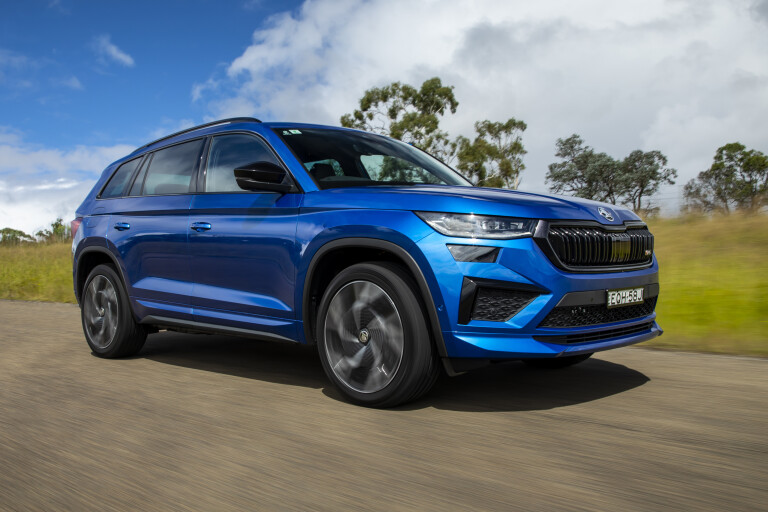
The two models would previously also have been split by choice of fuel, had the Kodiaq RS not switched from the original’s twin-turbo diesel engine to a turbocharged petrol four-cylinder as part of the SUV’s 2022 facelift.
It continues the demise of performance diesels that became trendy after Audi won the 2006 Le Man 24 Hours with its R10 TDI – before launching the popular SQ5 SUV.
Pricing and Features
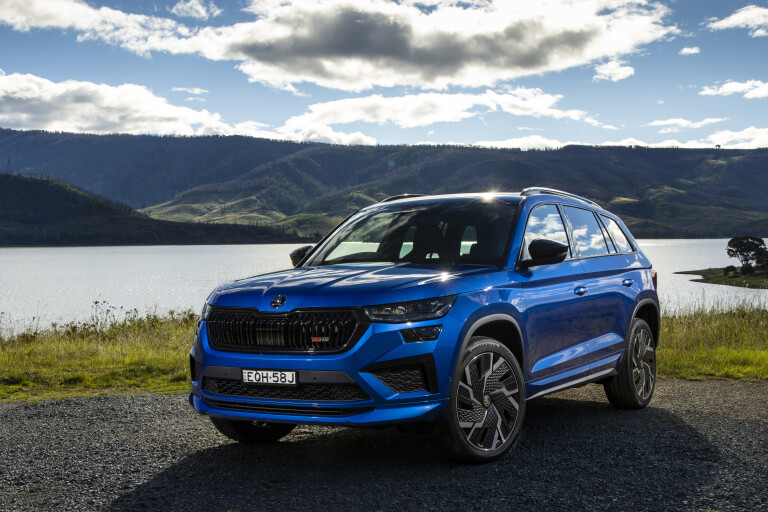
Although the cost of entry to Skoda’s halo model has risen $1450 to $67,440 before on-road costs, the RS’s value has improved – not least because the actual drive-away price has dropped by $1000 to $74,990.
A panoramic sunroof that was previously a $1900 option is now standard, and an expanded equipment list includes Matrix LED headlights, dynamic scrolling LED rear indicators, luggage nets for the boot, ‘Skoda’ puddle lights, and ventilation for the front seats that switch to full leather where previously the upholstery was a mix of Alcantara and leather.
For those staring at a $14,000-plus gap to the mid-range Sportline, the RS justifies more than half of that with standard gear
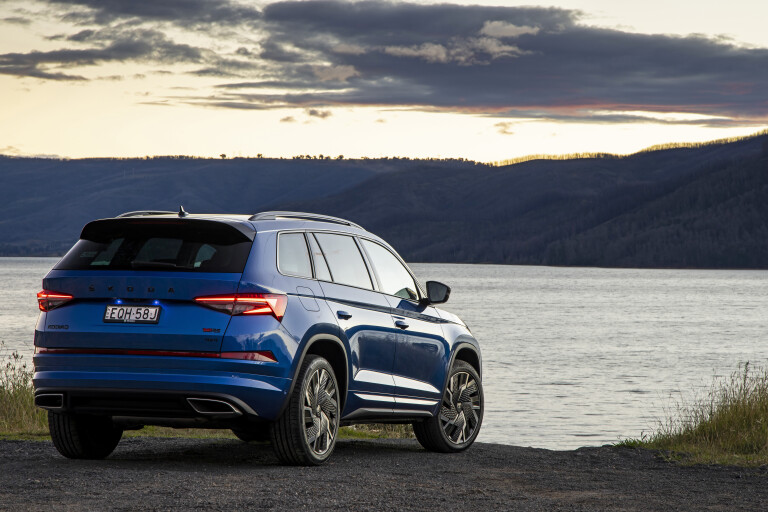
For those staring slightly wide-eyed at a $14,000-plus gap to the mid-range Sportline, the RS justifies more than half of that with standard gear that would require an $8500 spend in option packs and sunroof. That leaves buyers to assess the value of a more powerful engine.
Paintwork ranges from free (Steel Grey) to $1100 (Velvet Red), with $770 metallics in between – including an RS-exclusive Race Blue.
No bright Mamba Green, more’s the pity, as offered on the Octavia RS.
If seven seats aren’t a must-have feature, the $68,990 (before on-road costs) Tiguan R – which launches locally in April – looks tempting with its 235kW Golf R drivetrain, bigger 21-inch wheels and extra tech such as a head-up display.
On the Road
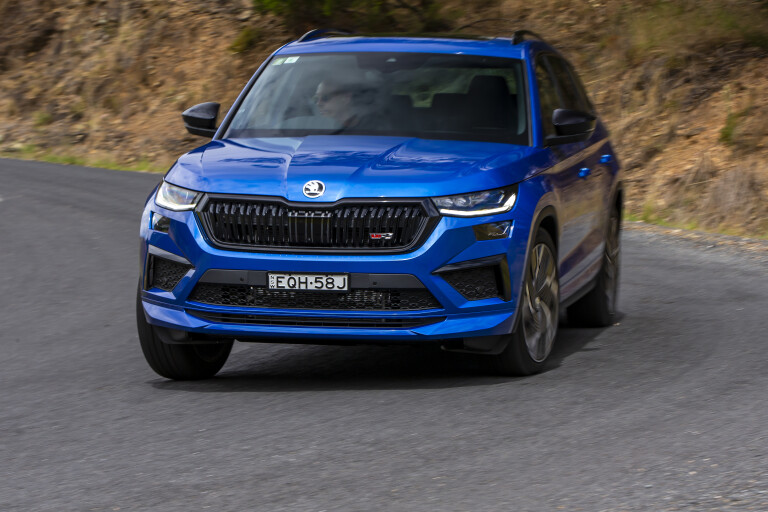
We’re focusing on the driving experience before areas such as cabin space and practicality – we’re presuming this is a priority for those considering the RS model; otherwise, a regular Kodiaq would surely suffice.
Thankfully, Skoda’s engineers have remembered their performance SUV is still aimed at families and haven’t made it excessively stiff.
Even the firmest Sport setting of the RS’s adaptive damper set-up is never jarring, though it can be busy – making the Comfort and Normal modes important options to introduce a more relaxing ride.

Driving modes are selected via a centre console button that brings up the various options on the central touchscreen. Either cycle through using that button or press your choice on the display.
Comfort can be largely left as a default choice for most driving and is the mode of choice for cushioning the blows that can come on potholed off-road trails. It’s also here where Skoda’s decision to go with 45-aspect rubber rather than a hardcore, super-thin tyre profile is appreciated.
Normal is a welcome middle setting for bumpier sections of country road; it is quicker to settle the Kodiaq whereas it can become floaty with its damping forces at their most passive.
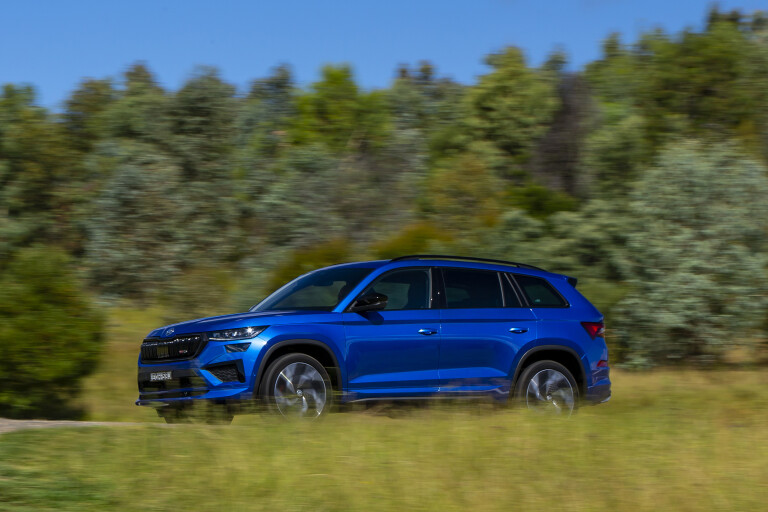
Body control through a series of corners is naturally at its tautest in Sport, a mode that brings out the best in the steering by adding some much-needed heft if no discernible feedback.
The Kodiaq RS is an enjoyable SUV to drive quickly because it steers with accuracy from right on centre, the brakes are strong and progressive, and there’s a surfeit of grip from the Continental ContiSportContact tyres.
There’s also less weight over the nose now, with the petrol engine saving 56kg compared with the former diesel donk.
Keen drivers stepping up to a family SUV – accustomed to hot-hatch thrills – need to temper expectations, as the RS delivers contentment rather than excitement

Any keen drivers stepping up to a family SUV for the first time – perhaps accustomed to hot-hatch thrills – just need to temper expectations, as the RS’s dynamics deliver contentment rather than excitement.
The same could be said about the RS’s EA888 ‘GTI’ engine (which is also employed in the Octavia RS sedan/wagon).
The 180kW/370Nm 2.0-litre turbo shaves a useful four-tenths off the diesel RS’s claimed 0-100km/h time, delivering a more respectable, if still unremarkable, 6.6 seconds (the Tiguan R is quoted at 5.1 seconds, for example).
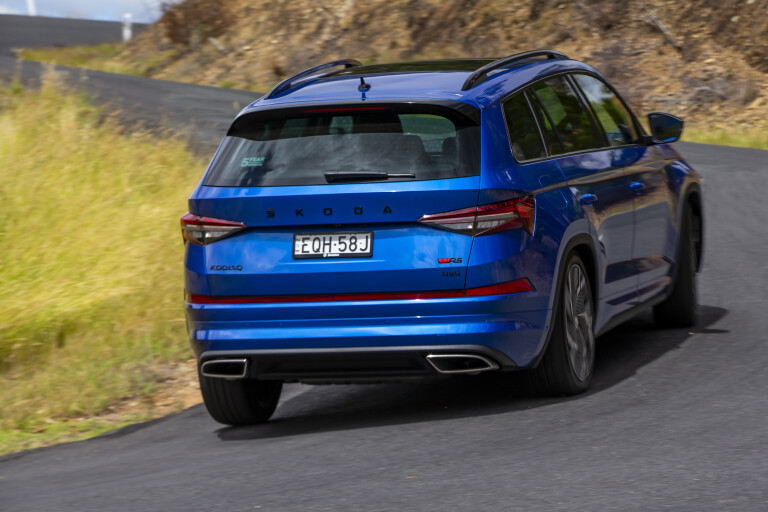
The extra thrust over the 132kW/320Nm turbo-petrol in the regular Kodiaq is also clearly evident.
While it’s an inherently sportier engine than the former turbo-diesel, it also concedes 130Nm. It’s a huge chunk of torque that doesn’t go unnoticed, though the petrol RS still provides a sufficiently potent mid-range for effective overtaking.
The petrol is thirstier and its higher-revving capability is also made irrelevant at times, with a transmission that overrides the driver’s paddle-selected gears even in Sport mode.
Skoda has given the four-cylinder an artificial soundtrack … the resonance of the fake noise can also be tiring, but relief is possible by putting the car in Comfort mode
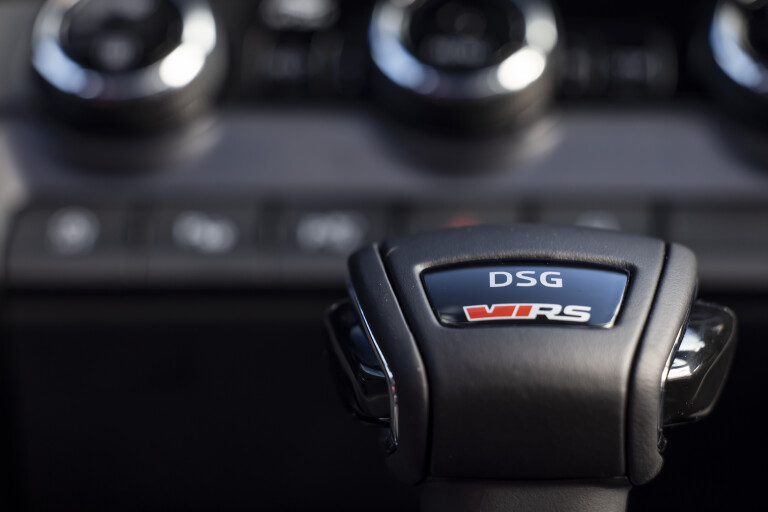
It’s not a big deal on more open, flowing country roads, but in tighter, uphill sections the dual-clutch auto’s habit of changing up prematurely reduces engine response when it’s most needed or wanted.
Skoda’s engineers have also given the four-cylinder an artificial soundtrack that could be dubbed ‘Audi RS3’, though you’re simply left wishing there was a real five-cylinder throbbing away under the bonnet.
The resonance of the fake noise can also be tiring, but – gratefully – relief is possible by putting the car in Comfort mode. It can also be turned off as a single element in the Individual setting, so it’s possible to enjoy a more natural four-cylinder sound with the RS in Sport mode.

While the Continental tyres are noisier than the Pirelli Scorpions that were fitted to the Kodiaq Sportline we tested the same week, the level never becomes intrusive.
A night-time country excursion that included off-road trails proved the excellence of the Kodiaq’s new Matrix LED headlights.
Comfort and Space
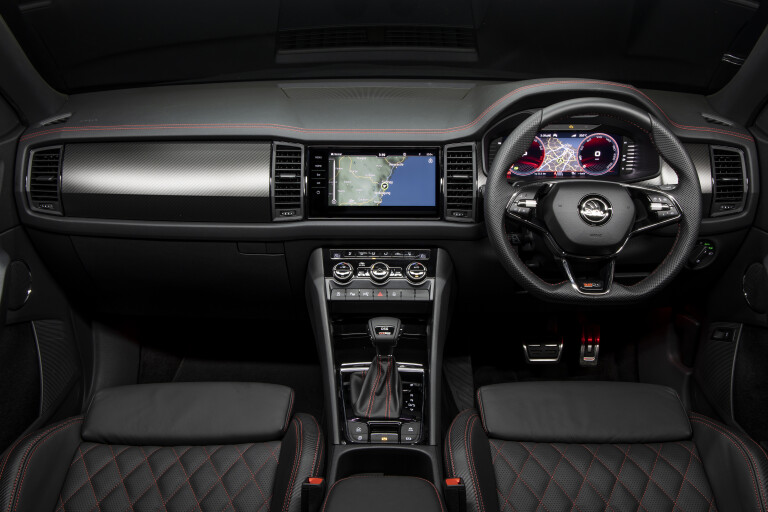
Skoda’s interior designers have made an effort to distinguish the RS’s cabin from the mid-range Sportline that has its own sporty flavour. Red stitching is omnipresent, weaved into the steering wheel, dash, door armrests, gear selector sleeve, and the upholstery (giving the diamond pattern greater emphasis compared with the standard all-black seats of the Sportline).
RS logos feature on the steering wheel, gear lever, start-up screens for the digital driver and infotainment displays, as well as the headrests of the sports seats. The bolstering features a carbon-fibre weave pattern.
The seat bolstering isn’t aggressive, again reflecting Skoda’s ethos of not going too extreme with its RS performance approach

Imitation carbonfibre is used for door inserts and the upper glove box, as they are in the Sportline.
Seat bolstering isn’t aggressive, again reflecting Skoda’s ethos of not going too extreme with its RS performance approach.
The rest of the interior experience is shared with other Kodiaq models. So, there’s excellent second-row space all round and plenty of light courtesy of the panoramic sunroof that’s standard only on the RS (but optional on the Style and Sportline).

In the third row, knee space is at a premium even if headroom is okay. Kids old enough to use a seatbelt will generally be fine back there, but there are no anchor points for child seats and adults would probably need an emergency session with their chiropractor if they were to spend more than half an hour there.
Quoted five-seater boot capacity of 765 litres puts the Kodiaq up there for luggage space, while its 270 litres with the third-row seats in place is also above average.
Storage throughout the cabin is as typically Skoda-thoughtful as we have come to expect from the brand.
Ownership

Maintenance costs for the Skoda Kodiaq RS can be bundled into the overall vehicle price via pre-paid service packs or spread out with monthly payments.
It’s a $2000 cost for a five-year service pack or $2900 for seven years (both $200 extra over regular Kodiaqs).
Monthly plans are determined by a choice of annual mileage and level of coverage. There’s a basic Value plan, a middle Essential plan that takes care of engine oil, batteries, wiper blades and brake discs/pads, and Complete throws in tyre maintenance.
The Skoda Kodiaq RS comes with a five-year factory warranty.
VERDICT

We’re not convinced that the switch from diesel has done the Kodiaq RS a huge favour. The petrol doesn’t transform Skoda’s large SUV into a thrilling drive, yet in the process does lose some mid-range shove as well as fuel efficiency.
The VW Tiguan R also looks better value on paper, and the Sportline is our pick of the Kodiaq range.
But if you’re looking for a vehicle that pairs performance with seven-seater pragmatism – as well as ride comfort that will get the tick from non-enthusiast partners – then the Kodiaq RS is well worth a look.
2022 Skoda Kodiaq RS specifications
| Body | 5-door 7-seat SUV |
|---|---|
| Drive | all-wheel |
| Engine | 2.0-litre turbocharged four-cylinder petrol |
| Power | 180kW @ 5250-6500rpm |
| Torque | 370Nm @ 1600-4300pm |
| Transmission | 7-speed dual-clutch auto |
| 0-100km/h | 6.6 seconds (claimed) |
| Weight | 1790kg |
| Fuel consumption | 7.5L/100km (combined) |
| Suspension | strut (front), multi-links (rear) |
| L/W/h | 4699/1882/1685mm |
| Wheelbase | 2791mm |
| Tyres | Continental ContiSportContact 235/45R20 (f/r) |
| Wheels | 20-inch ‘Sagittarius’ alloys |
| Price | $67,440 before on-road costs ($74,990 drive-away) |
Score breakdown
Things we like
- Variable dampers deliver ride comfort and body control
- Quality cabin with suitably sporty aesthetic
- Third-row flexibility
Not so much
- Artificial engine sound; disobedient gearbox
- Not especially quick
- Tiguan R looks better value if extra seats aren’t needed



COMMENTS